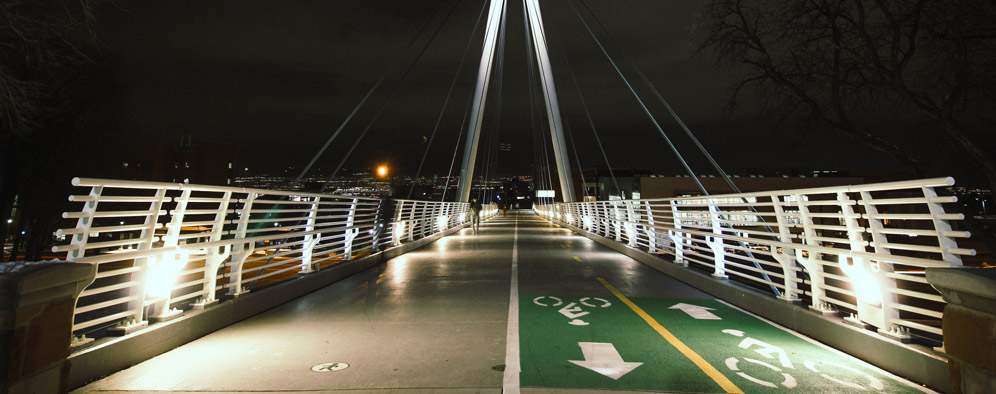
By Abeni Czajkowski
The safety of all students, faculty and staff is a top priority for the University of Utah. For the past 18 years, administrators, safety experts and volunteers have worked together and focused on ensuring a well-lit and safe campus at night. At the same time, recent sustainability and environmental measures have increased focus on reducing light pollution and helping the U to become compliant with the dark sky initiative of minimizing light trespass and skyglow with specially approved light fixtures.
Walk after dark
When identifying areas of campus that are too dark or seem unsafe, it’s best to experience it first-hand. Occupational and Environmental Health and Safety (OEHS) sponsors an annual “Walk After Dark” during which participants walk every sidewalk on campus to identify areas of concern. Team members use their phones to mark exact GPS locations where they find potential safety issues with lighting.
“The walk occurs in the fall after the sun sets, the leaves are full and the moon is hidden — a night of ‘optimal darkness’” said James Stubbs, associate director of OEHS. “We also identify uneven pavement, broken light fixtures, areas of perceived darkness versus actual darkness and landscape elements that interfere with the light or could provide a potential hiding place. We then analyze the data found in order to find solutions to the problems.”
Ensuring proper lighting across campus was a priority of the Presidential Task Force on Campus Safety, which requested and received $125,000 for that purpose in this year’s budget.
Light pollution mitigation
The first steps in preventing light pollution is understanding what it is. One example of an inefficient light fixture is the “lollipop light pole,” which distributes uncontrolled light. These are being replaced with more efficient fixtures that keep campus areas brightly lit while also reducing light pollution from “sky-glow.”
“Light pollution is wasted energy in the form of artificial light that impairs one’s ability to see the night sky,” said Bill Leach, sustainability projects coordinator with Facilities Management. “It’s not as simple as just turning off the lights in a campus setting. It’s not just about getting rid of lights but it’s controlling light, working to make sure it’s going where we want it to go and not outside of its parameters.”
Light pollution not only affects the night sky but it affects our bodies as well as the surrounding environment and the inhabitants within it. Motivations to become a Dark Sky Compliant campus include health-related concerns, the environment, wildlife and sustainability efforts.
So how do you control light?
The University of Utah is replacing current fixtures with Dark Sky-Friendly LED lighting. LED light beams travel in a more linear path and therefore can be easier to control. These fixtures don’t allow the light to escape above its horizontal plane. The new fixtures help to minimize contributions to sky glow through spectrum intensity, color temperature and shielding.
“There is no black and white answer for what is adequate because light levels in a given area are perceived differently by each individual,” Leach said. “We can help people feel more safe using lighting but we cannot give it a one-size fits all answer. The night sky is there but people don’t often get to see it in an urban setting. We are working hard and will continue doing so to find a balanced solution.”
Resources
The U offers a number of resources that allow campus community members to raise concerns with lighting safety, which can be found here. Campus police also are available to escort you to a residence hall or vehicle at night, which can be arranged by calling 801-585-2677.
- Report a light out by clicking here
- Lighting safety information can be found here
- SafeU website
- Campus Police: 801-585-2677
For more campus resources on Dark Sky Compliance:
- Consortium for Dark Sky Studies
- Colorado Plateau Dark Sky Cooperative
- The AstronomUrs (Star and solar parties)
- South Physic Observatory
